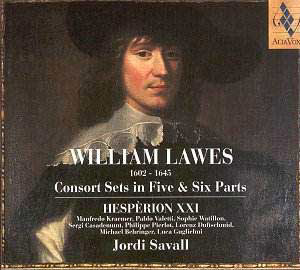In the notes to this set, Jordi Savall suggests that
William Lawes’ consort sets "deserve to be ... known as one of
the most original masterpieces of chamber music of all time," and
compares them to Dowland’s Lachrimae, Purcell’s Fantasias,
Bach’s Art of Fugue, Haydn’s Seven Last Words of our Saviour
on the Cross and Beethoven’s late string quartets. This is impressive
company indeed, and, while this music is profound and moving, I’m not
sure that it deserves such accolades.
Consort sets are like suites - each one contains several
movements (three or four) in the same key, developing the same themes.
The 5 part consort sets are played by 5 viols and organ, and the 6 part
sets by 2 violins, 4 viols and organ. Savall and his fellow musicians
play this music with a great deal of emotion and technical expertise,
but what stands out most with this music is the atmosphere and overall
sound. The lush, rich sound of viol consorts is a delight to the ear,
with beautiful textures and enchanting tones. But the unity of the consort
makes it more difficult to hear the individual lines than, say, with
a string quartet, which has a more incisive sound. This music must be
listened to more closely to be appreciated, but the effort is worth
it.
The beautifully subtle counterpoint here in some of
the slower movements and the energetic playing of the fast movements
balance each other out; this music needs to be heard on a large scale,
that of an entire consort set, to be fully appreciated. This is a fine
recording, showing the technical expertise that Savall brings to such
works. It certainly deserves to be discovered by those unfamiliar with
this repertoire. For those familiar with the viol consort, this is an
essential recording of some of its finest music.
Kirk McElhearn


